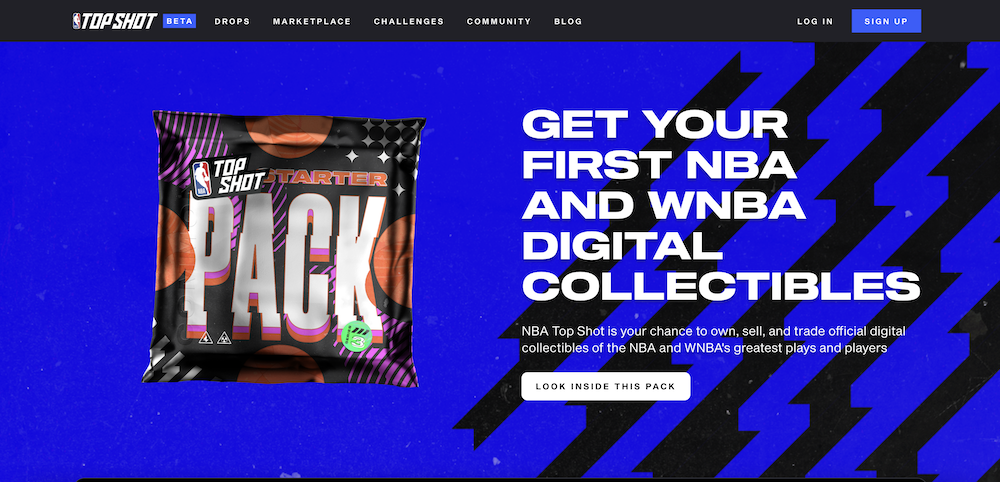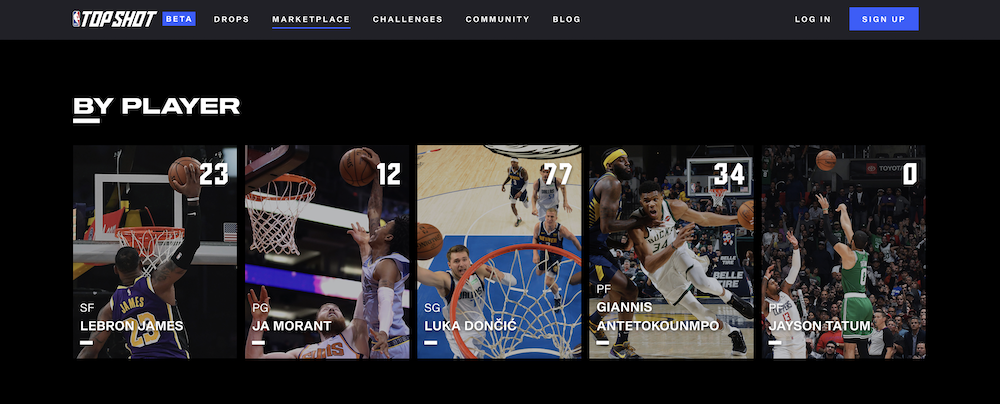Nothing but net worth: Sports collectibles cross over to the blockchain
Professional Sports Authenticator (PSA), widely considered the preeminent trading card authentication and grading company, suffered a reported backlog of about 14 million cards last spring. It consequently had to expand its offices and hire and train more graders just to cut the backlog by half. Other major grading companies, such as Beckett Grading Services (BGS), were also overwhelmed. This never-before-seen quandary made NFTs attractive to frustrated and impatient card collectors.
Ever since an NFT of a LeBron James slam dunk sold for a few hundred thousand dollars in February 2021, it’s been clear that digital collectibles have transformed the hobby of sports collecting, and while the shift may have some downsides, the advantages are evident. Notably, unlike trading cards and autographed baseballs, NFTs don’t require time-consuming authentication or grading, and in theory they’re impossible to counterfeit.
Tyler Holzhammer, content producer at Sports Card Investor (and godson of baseball Hall of Famer Andre Dawson), recognizes both the pros and cons of NFTs when compared to traditional collecting. “The benefits of NFTs include instant transactions, no shipping, no concern about returns, and no grading,” he said. “It’s a slick and smooth marketplace to buy and sell.”
“But,” Holzhammer continued, “there are cons with NFTs. Nothing is sent to you, so you can’t have an item in your hands like with a card or piece of art. Plus, we know the longevity of the value of physical cards, whereas the value of NFTs might get diluted.”
Ian Linde, CEO of Collectionzz and a veteran Wall Street trader, emphasizes the marketability of NFTs, while also taking a skeptical, Economics-101 perspective.
“NFTs fit the digital world,” he observed. “Millennials embrace digital content, and NFTs attract a big audience. It’s good that NFTs are aligned with a digital currency.” Still, Linde noted, “there’s lots of speculation, the ability to manipulate, and no true regulation. Value becomes debatable because there is no price history or data points. It’s based on whatever people accept the value to be.”
“Cashing out was especially an issue early on, but has been pretty smooth for me and has been streamlined,” said Holzhammer. “I’m optimistic about the future.”
Still, it’s unwise to rely on NFT sales to pay bills or rent. It’s equally unwise to become obsessed. The ease, speed, immediate gratification, and lack of tactility when buying and selling NFTs potentially make it an addictive activity. To combat this possibility? “Invest, don’t gamble,” Holzhammer advised.
“Like with anything else, it’s about managing expectations and staying in your lane,” Linde added. “It’s important to read, do your research, be realistic, but still have fun with it.”
The ease and speed of transaction can be seen as a positive, too, for both digital and physical sports collecting. Technology has quickened the pace of the market and analysis.
“Back in the day, you waited a month to see what the collecting magazines had to say,” recalled Holzhammer, who’s been collecting since he was eight years old. “Now it’s an hour-by-hour cycle.” Websites such as Sports Card Investor use advanced metrics and tools to track the value and growth of sports cards. Population reports, which display the rarity of a card, and a variety of other charts, can help hobbyists make smarter investments.
When worlds collide
“There is a big enough audience for physical collecting, and I think it will thrive over the next 10 years without a doubt, and at least remain popular for the next 50 years,” Linde believed. “Sure, the pendulum will sway over time, but [physical and digital collecting] can coexist happily.
“The underpinnings of collecting are emotion, passion, and making money—whether it involves cryptocurrency or not.”
Holzhammer shares Linde’s confidence and predicts a symbiotic relationship between physical and digital collecting.
The last few years are reminiscent of the chicken-and-egg dilemma: Did the NFT craze lead to the boom in physical collecting, or did a spike in physical collecting cause the digital mania? Experts posit that it’s a mix of both, only fueled by the pandemic.
Holzhammer agrees. “During the pandemic, people could go down the collecting rabbit hole. They looked for old cards and began browsing eBay. Others tried to find opportunities to make money outside of the physical space. The crypto crowd stumbled upon NFTs and made them popular.”
“An NFT of an actual item can be good for the value of that item because the NFT will bring an extra awareness to it,” Linde said.
Holzhammer thinks it’s an interesting concept, though not without its flaws. “It would be cool to see a Michael Jordan ‘flu game’ NFT or something similar,” he mused. “But it can be tricky to determine value and what you’re actually getting, especially if a player puts out his own NFT that’s not associated with a company.
“Plus, I’d rather have the photo that inspired the NFT. I think the real thing tells a better story.”
However, Holzhammer is intrigued by Digible, a company that describes itself as “the world’s first NFT marketplace backed by rare physical collectibles.” He believes its hybrid format will be the wave of the future, akin to “sports card collecting on steroids.”
NFTs might already be on steroids. The madness surrounding them has been legitimized by the participation of traditional auction companies: Christie’s, Phillips, and Sotheby’s have all sold high-value NFTs, some for tens of millions of dollars. Sports card giants entered the game as well; Topps debuted a Major League Baseball NFT collection last spring, and Upper Deck has partnered with the National Hockey League. Almost every major league and team has a token collection, and sports media companies, many struggling financially, view NFTs as a source of revenue. Sports blog Bleacher Report has been heavily involved—last year, with the collaboration of celebrities, it auctioned off NBA All-Star Weekend art. According to Sportico, this venture brought in $810,000 in sales.
“NFTs have the potential to greatly expand a company’s audience,” Linde said. “It would be foolish for corporations not to jump even further into this trend.”
“It’s been a race to get into the NFT arena, but companies will become more methodical as time goes on,” Holzhammer insists. He’s been surprised by the seemingly infinite number of influencers and newcomers who’ve thrown their weight behind the crypto economy.
If done prudently, investing in collectibles, whether physical or digital, can rival traditional forms of investing. In recent years, sports card investments have often outperformed the S&P 500, money markets, and certificates of deposit. Should people shift some of their money from stocks to Mickey Mantle cards? Again, the answer isn’t simple.
“There will be ups and downs in collectibles, just like in the regular market,” said Holzhammer. “It’s about investing wisely and picking the right individuals and right grades whose value will have longevity. If you’re a sports fan, you can use your gut feeling to invest, while it’s tougher for an average person to do that in the stock market.”
“Some may find it easier and quicker to move NFTs than stocks, and I know people probably tie more emotion to sports and art items, but neither is better than the other,” Linde observed. “Wall Street trading, collecting, and NFTs all involve supply and demand, liquidity, speculation, and some form of gambling.”


Screen shot of the NBA Top Shot website

Screenshot of the Collectionzz website
Holzhammer immersed himself in the NFT world in January 2021, when NBA Top Shot—the league’s official marketplace for digital collectibles, or “moments”—became all the rage. NBA Top Shot provided him with a “smooth” user experience and a chance to learn about NFTs in a fun, low-pressure environment.
Linde has also “dabbled” in Top Shot, using it as an “educational” experience. He believes the platform, despite its early and rapid success, has yet to peak. “This is an early-innings type of situation, there’s still plenty of growth to expect.”
Linde runs Collectionzz, an online platform where collectors and fans can interact, buy memorabilia, and sell it. Collectionzz centers on music collectibles, but items from sports and entertainment are also featured in the marketplace (Linde himself is the proud owner of one of the world’s most extensive rock music memorabilia collections, including rare Kurt Cobain guitars, handwritten setlists, and Pearl Jam memorabilia). He and his team are learning about NFTs and how to connect them to “what people care about.” The website can help bands and musicians promote and sell their art, and under the umbrella of Collectionzz is Iconic, which sells unique prints and posters tied to past “iconic” concerts, Linde’s team works with firms and illustrators to create these officially licensed pieces. NFTs seem like an appropriate fit within these business models.
Relevance for the future
When it comes to collecting, Holzhammer warns not to be swayed by popular influencers. Instead, he recommends finding corners of the market that have yet to be swamped. Hockey and soccer cards, Marvel cards, tickets, and programs have all been overlooked, according to Holzhammer. At any rate, he encourages investors to chase significance, not mutable trends or prices.
“I like to do a player analysis before a product analysis,” said Holzhammer . “For example, if you gave me $500 to invest right now, I’d probably put it into a Jackie Robinson card because he’ll always have significance. The key is also to specialize in what you like and know about. And everybody makes mistakes, so don’t be afraid to dive in.”
It’s difficult, though, to dive in as a cash-strapped teenager or young adult. Holzhammer recommends Dibbs, an online marketplace where users can acquire fractional ownership of authenticated sports cards. These cards, according to Dibbs’ website, are “stored in vaults and secured with blockchain technology.” Buying a fraction of a card can be less expensive and daunting. “Dibbs has a good synergy and a Robinhood [trading app] feel,” Holzhammer said.
The frenetic pace of the NFT market has led some experts to draw comparisons to the dot-com bubble and its subsequent burst. But the web outlived pets.com–NFTs will outlive market turbulence, too.
Linde isn’t worried. “NFTs are here to stay,” he said. “There will be ups and downs, there might be a correction, but the NFT market will continue to evolve. There’s a lot of merit—everyone is involved: players, teams, leagues, celebrities, and companies.”
“An empire is being built,” Holzhammer asserted, similarly bullish. “Right now, we are in the beginning stages. Creativity will fuel the market and take it to the next level. There’s already been a bit of a slowdown and correction in NBA Top Shot, because prices got too high too fast. But it’s a good blueprint and will remain popular. Cryptocurrency is here for the long run.”
“The NBA knocked it out of the park and knocked its competition out, too,” Holzhammer said. “It was important that the NBA and the Players Association backed Top Shot. Some players even invested.”
NFTs have opened a new door for athletes. Players have used digital collectibles to market themselves, and consequently acquire more power and earn more money. In March of last year, Rob Gronkowski became the first athlete to debut an NFT collection. Many followed suit, including NCAA stars, who can use the sale of NFTs as a source of income. It sounds like yet another case of the gap expanding between the superstars and the less-known majority of players. But NFTs are having an unexpected, opposite effect.
“Certain athletes, like Patrick Mahomes, will obviously be able to thrive due to their star power,” Holzhammer said. “But NFTs can also bring attention and revenue to lower-tier players.” He points to Charlotte Hornets guard Terry Rozier, a solid player but not a household name. Rozier has given away tickets, meet-and-greets, and game-worn jerseys and sneakers to fans who have purchased his NFTs. He’s also participated as a collector, buying teammates’ and competitors’ “moments,” and has often discussed Top Shot on social media.
Revenue and relevance propel the wheel of sports. NFTs provide both. Leagues and teams see digital collectibles as a way to engage the device-obsessed, younger demographic. NFTs could be used to coax the youth back into stadiums and arenas with special offers, such as in-game experiences, perks, and merchandise.
As with anything new, the NFT and crypto worlds are speckled with imperfections. Bad actors have emerged. Cases of money laundering have been uncovered. There have been security breaches and legal issues. But this hasn’t fazed most investors or companies.
Holzhammer is impressed by the endurance of the cryptocurrency universe. “The system has been put through a variety of stress tests, so I’m not too worried,” he stated confidently.
“Like anything else, it will probably need some form of regulation,” Linde predicted.
With NFTs, it’s hard to discern what is real and what is not. And most people still don’t know what cryptocurrency is—maybe it should be renamed cryptic-currency. Others refuse to trust what they can’t see. Yet, the crypto beat goes on.
“I read that people who are still physically collecting are just like the people who were clinging to compact discs when MP3 players were coming out,” Holzhammer said with a chuckle. “But those trading cards, those pieces of cardboard, still matter.
“It’s all about what is considered historic and valuable.”

Peter Kropf is a sports journalist based in New York City. He explores the often overlooked human side of sports. His work can be found at https://muckrack.com/peter-
Art

Curated Conversations: ALIENQUEEN
SuperRare Labs Senior Curator An interviews ALIENQUEEN about psychedelics, death, and her journey in the NFT space.
Tech


Out of the Vault and onto the Chain: the Evolving Nature of Provenance
SuperRare editor Oli Scialdone considers the social experience of provenance and its relationship with community in the Web3 space.
Curators' Choice



Curated Conversations: ALIENQUEEN
SuperRare Labs Senior Curator An interviews ALIENQUEEN about psychedelics, death, and her journey in the NFT space.




